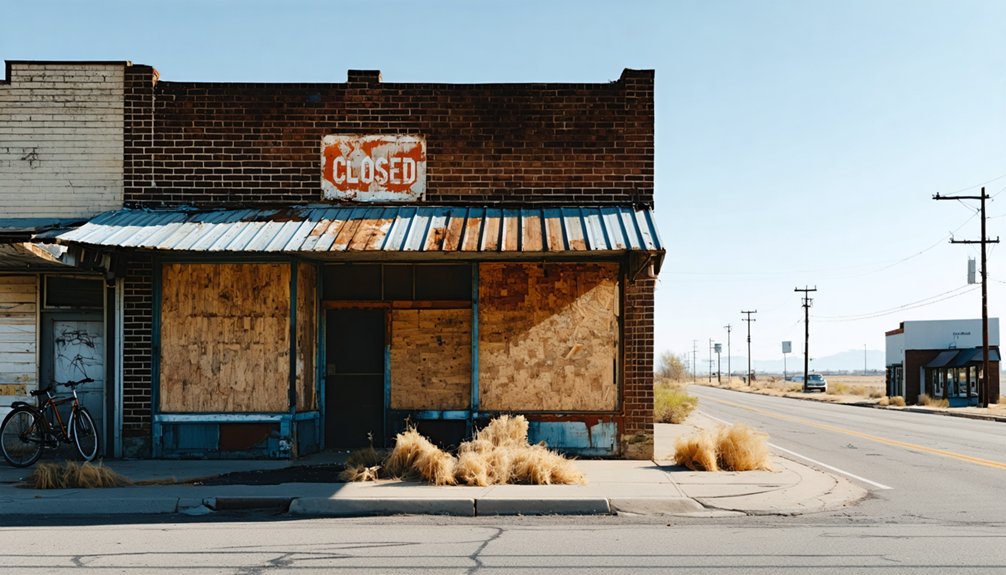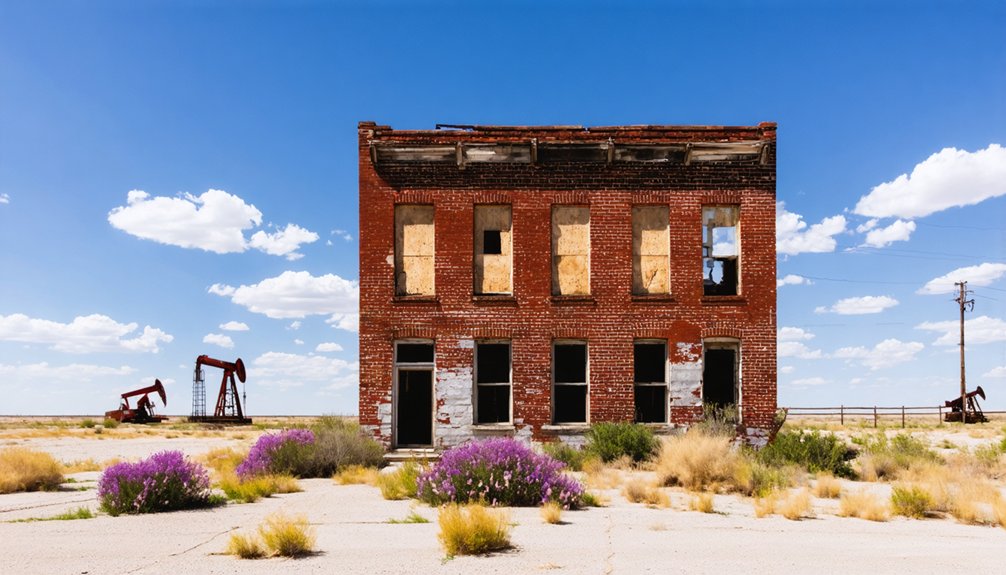You’ll find Perico’s haunting remains in the Texas Panhandle, where only its school gymnasium still stands. Originally named Farwell, this Fort Worth and Denver City Railway town emerged in 1888 and thrived as an agricultural hub until the 1970s. The community’s decline began when Highway 287 bypassed the business district, leading to its eventual abandonment. Perico’s weathered walls hold stories of frontier innovation, railroad commerce, and the transformation of Texas ranchlands.
Key Takeaways
- Perico, Texas became a ghost town by 1990, declining from its peak as a railroad community established in 1888.
- The town’s demise was accelerated by highway construction bypassing the business district and rerouting of major transportation routes.
- Originally named Farewell, the settlement was renamed Perico in 1905 and served as an agricultural hub with essential services.
- The last remaining structure is the school gymnasium, symbolizing the community’s educational legacy and social gatherings.
- Population dwindled to 40 residents by the 1960s, with the post office closing by 1970 and school shutting down.
The Railroad Town That Was
When the Fort Worth and Denver City Railway established a railroad siding in 1888, they laid the foundation for what would become Perico, Texas. Originally named Farewell, this strategic point served the XIT Ranch’s Farwell Park line camp just a quarter mile north.
By 1905, railroad expansion brought a new name – Perico – along with essential infrastructure including a boxcar depot and water tower. The Perico General Mercantile opened in 1920, becoming a vital supply center for the community.
The arrival of the railroad in 1905 transformed Farewell into Perico, equipping the site with vital transportation facilities.
You’ll find Perico’s community evolution reflected the changing landscape of the Texas Panhandle. As the vast ranchlands of Dallam County transformed into farmland in the early 1900s, Perico emerged as a crucial agricultural hub. A remarkable example of frontier construction occurred in 1907 when eight workers built a house in just four days.
The town grew to support both railroad operations and farming needs, complete with worker housing and a school serving grades one through twelve.
From Farwell to Perico: A Name’s Journey
You’ll find that Perico’s history began under a different name – Farwell – which recognized the Farwell brothers who helped build the Texas Capitol in exchange for XIT Ranch lands.
The name change occurred in 1905 when George Findlay of the Capitol Syndicate requested the railroad rename the siding from Farwell to Perico. The shift required careful documentation to avoid confusion, as place name disambiguation became increasingly important for record-keeping.
This changeover from Farwell to Perico coincided with the broader transformation of the area from ranching territory to agricultural settlement, marking a significant shift in the community’s identity. Unlike other towns of that era, Farwell was known for its well-built structures including a bank, churches, and schools.
Railroad Requests Name Change
In 1905, the Capitol Syndicate’s George Findlay set in motion a significant change for the Texas Panhandle railroad landscape by formally requesting that the railroad rename its Farwell siding to Perico.
This name change significance reflected the growing need to establish distinct community identities along the expanding Texas railway system. The addition of new rail lines, including the crucial Belen Cutoff in 1908, made clear station identification even more essential. The process helped avoid place name confusion among similar locations across the region.
The Spanish-derived name “Perico” would create lasting impacts:
- Distinguished the small siding settlement from the larger Farwell community
- Reflected the cultural influences shaping the Texas Panhandle
- Helped railway operators manage traffic more effectively between mainlines
- Established a unique identity for the developing settlement
The railroad’s control over station naming was standard practice, ensuring clear identification across the rapidly expanding network of Texas towns and preventing confusion among travelers and operators alike.
Early Identity Transformation
Through a pivotal shift in 1905, the small railroad settlement of Farewell underwent a defining transformation to become Perico, marking more than just a simple name change.
This identity evolution reflected broader changes sweeping through the Texas Panhandle, as vast ranches gave way to smaller agricultural settlements. The Spanish-derived name “Perico” embraced the region’s multicultural influences while signaling the community’s aspirations beyond its humble railroad siding origins. The establishment of Capitol Reservation Lands in the area helped drive the transition from large cattle operations to smaller homesteads.
At the request of George Findlay from the Capitol Syndicate, you’ll find this renaming aligned with a common trend among Texas towns seeking to attract settlers and establish stronger identities. The change proved timely, as Perico soon developed into an educational and service hub for surrounding farmers, though its promise of sustained growth would later fade with changing transportation patterns. The area’s connection to the Texas Capitol builders, John V. and C. B. Farwell, influenced early development patterns in the region.
Agricultural Roots and Early Growth
You’ll find Perico’s agricultural roots firmly established in the early 1900s, when the W. P. Soash Land Company began subdividing large ranchlands into smaller farming parcels.
The town’s strategic location along the Fort Worth & Denver Railroad made it an ideal shipping point for local farmers, spurring the development of essential commerce and services. Like many other communities that faced decline when Route 66 was rerouted, Perico’s fate was sealed by changing transportation patterns.
These agricultural foundations supported the growth of community institutions, including a school and post office that served both the town’s residents and surrounding rural families. The town experienced a steady decline until its population hit zero by 1990.
Farming Drives Town Development
During the early 1900s, Perico’s transformation from ranch territory to farmland sparked significant growth in this Texas settlement.
The W. P. Soash Land Company’s active promotion of farming opportunities brought waves of settlers seeking economic sustainability through agriculture. You’ll find that farming technology and agricultural development became the town’s economic foundation, with the climate perfectly suited for crops and livestock.
The impact of this agricultural boom manifested in four key ways:
- Establishment of a post office in 1905
- Construction of schools and a gymnasium for farmers’ families
- Development of markets and agricultural services
- Creation of a stable population base of forty residents
This farming-driven development supported Perico’s growth through the first half of the 20th century, shaping the community’s identity as an essential agricultural hub.
Railroad Creates Local Commerce
As railroads expanded across Texas in the late 1800s, Perico’s economic landscape transformed dramatically thanks to generous land grants and financial incentives established by the 1876 Texas Constitution.
The railroad impact brought more than just steel tracks – it slashed transportation costs and opened new markets for local farmers and businesses.
You’d have found Perico bustling with commercial activity as the rail connection attracted immigrants, workers, and investors.
The town’s strategic location along the growing Texas rail network, which reached over 9,000 miles by 1900, positioned it perfectly for commerce growth.
Like many railroad towns of the era, Perico developed essential services including stores and processing facilities.
The railroad didn’t just move goods; it brought new opportunities, connecting this small Texas town to regional markets and the nation’s expanding economic system.
Life Along the Fort Worth and Denver Tracks
While the Fort Worth and Denver City Railway transformed northern Texas’s landscape after 1873, life along its tracks became a symbol of American frontier development.
You’ll find remarkable examples of community resilience in towns like Perico, where railroad history shaped daily existence. The railway’s presence created vibrant communities where freedom and opportunity flourished.
Life along the tracks meant:
- You’d witness constant movement of cattle, crops, and manufactured goods through bustling freight stations.
- You’d find yourself among diverse workers, from engineers to maintenance crews, forming tight-knit railroad communities.
- You’d see local businesses spring up around rail stops, including hotels and general stores.
- You’d experience the pulse of communication and commerce connecting remote areas to major markets.
The School Gymnasium: Last Standing Sentinel

The weathered school gymnasium stands alone in Perico today, a solitary reminder of the town’s vibrant past. You’ll find this last remaining structure quietly keeping watch over the empty plains where a thriving community once existed.
The gymnasium’s worn walls hold memories of basketball games, community gatherings, and school events that brought the townspeople together.
While time and the elements have taken their toll on this sentinel of Perico’s history, its presence serves as a reflection of the educational foundation that once anchored local life.
Though the classrooms, hallways, and other school buildings have long since vanished, this gymnasium continues its lonely vigil, inviting you to imagine the echoes of cheering crowds and squeaking sneakers that once filled its now-silent space.
XIT Ranch Legacy and Rural Development
Long before the gymnasium stood sentinel over Perico’s empty plains, XIT Ranch shaped the destiny of this Texas Panhandle region. The XIT influence transformed these grasslands from open range to settled communities, marking a pivotal shift in Texas ranching history.
The XIT Ranch transformed the untamed Texas Panhandle, turning vast grasslands into a tapestry of thriving settlements and agricultural promise.
You can still trace the ranch’s legacy across the landscape where:
- 800 miles of barbed wire once divided 3 million acres spanning ten counties
- 150,000 head of cattle grazed the short-grass prairie
- Cowboys maintained one of Texas’ most innovative ranching operations
- Early settlers carved out homesteads from former XIT territory
This ranching legacy lives on in the region’s DNA, where population grew from just 778 in 1900 to 46,000 as the XIT’s vast holdings were subdivided, forever changing the Panhandle’s character from cattle kingdom to agricultural community.
Highway Changes and Town Decline

As new highway construction bypassed Perico’s business district in the mid-20th century, this once-bustling agricultural community began its descent into ghost town status.
The rerouting of Highway 287 and U.S. Highway 87 drastically altered traffic patterns, cutting off the steady flow of travelers who’d previously sustained local businesses.
You’ll find that economic isolation quickly followed as commerce dwindled. The post office closed by 1970, and the school – once a vibrant community hub – shuttered its doors.
By the 1960s, only 40 residents remained, and that number continued to plummet. The town’s fate mirrored other Texas Panhandle communities where highway changes sparked cascading business closures.
Without passing motorists to support gas stations, shops, and services, Perico’s buildings fell into disrepair, leaving only abandoned structures as evidence of its former significance.
Modern Day Traces in the Texas Panhandle
Remnants of Perico’s past dot the Texas Panhandle landscape today, with the dilapidated gymnasium standing as the most prominent survivor among the town’s original structures.
Located 11 miles southeast of Texline along U.S. Highway 87, this ghost town‘s rural heritage remains visible through scattered ruins and agricultural remnants.
As you explore this piece of town history, you’ll encounter:
- Broken windows and weathered walls of the abandoned school gymnasium
- Active railroad tracks that once brought life to this farming community
- Foundation stones marking where buildings once stood
- Old farm equipment and irrigation remnants scattered across the surrounding fields
The site’s accessibility via two-wheel-drive roads makes it easy to visit, though you’ll find no tourist infrastructure or preservation efforts maintaining these last traces of Perico’s existence.
Frequently Asked Questions
Were There Any Notable Crimes or Incidents in Perico’s History?
You won’t find any documented crime incidents in Perico’s historical records. Unlike other nearby ghost towns that had violent episodes, Perico maintained a peaceful existence focused on agriculture and education.
What Happened to the Original Residents When the Town Declined?
Like birds seeking greener pastures, you’ll find the original residents scattered to larger Texas towns during the economic decline, driven by residential migration toward better jobs, schools, and amenities nearby.
Are There Any Ghost Stories or Local Legends About Perico?
You won’t find any haunted tales or local folklore about Perico in historical records. Unlike other Texas ghost towns, there’s no documented evidence of supernatural stories or paranormal legends from this location.
Can Visitors Legally Explore the Remaining Structures in Perico Today?
Like a locked vault of history, you can’t legally explore Perico’s structures without explicit landowner permission. There’s no documented public access, and visitor guidelines require obtaining consent to avoid trespassing violations.
What Natural Disasters or Severe Weather Events Affected Perico’s Development?
You won’t find any documented flood impact or drought effects in Perico’s history. Historical records show no major natural disasters shaped the town’s development or decline during its active years.
References
- https://www.ghosttowns.com/states/tx/perico.html
- http://david.meccahosting.com/~a0008fd1/house_in_perico_1907.htm
- https://en.wikipedia.org/wiki/List_of_ghost_towns_in_Texas
- https://www.texasalmanac.com/places/perico
- https://www.texasescapes.com/TexasGhostTowns/Perico-Texas.htm
- https://www.texasescapes.com/TexasGhostTowns/PericoTexas/Town-we-are-approaching-was-Perico.htm
- https://www.davickservices.com/house_in_perico_1907.htm
- https://www.tshaonline.org/handbook/entries/perico-tx
- https://texashistory.unt.edu/ark:/67531/metapth162509/m1/666/?q=Perico
- https://mix941kmxj.com/an-interesting-story-of-texas-town-that-seems-to-have-disappeared/



